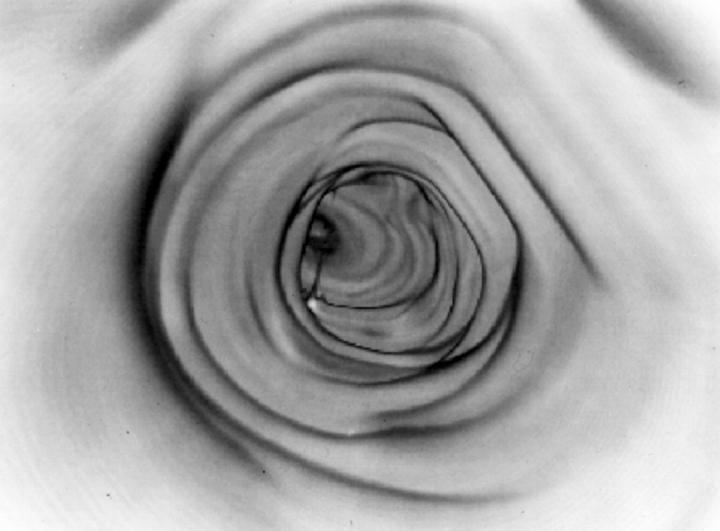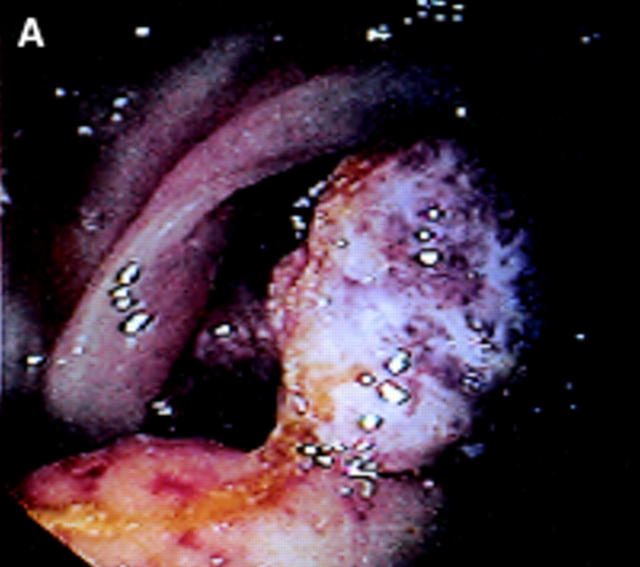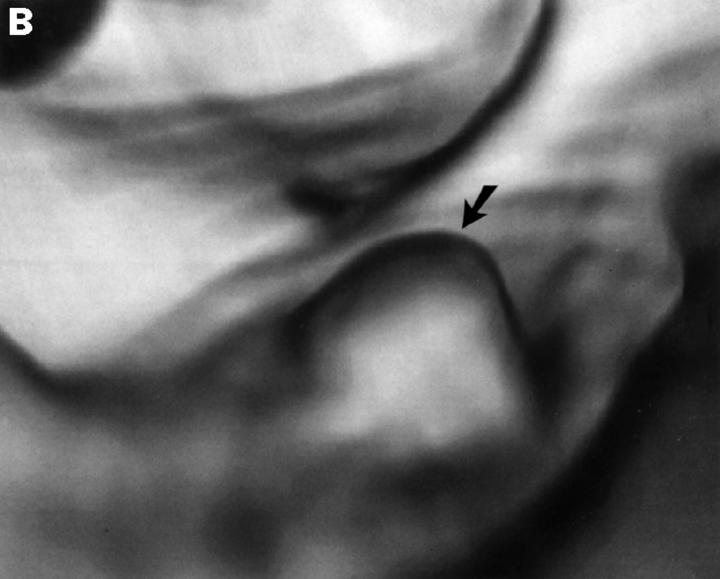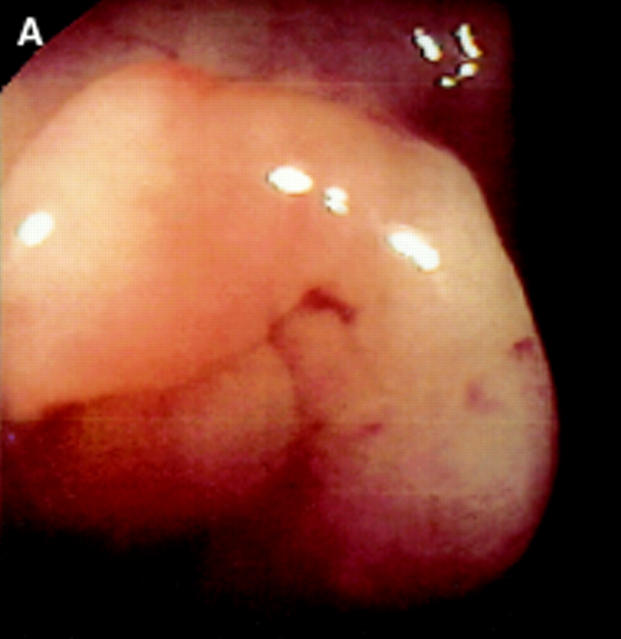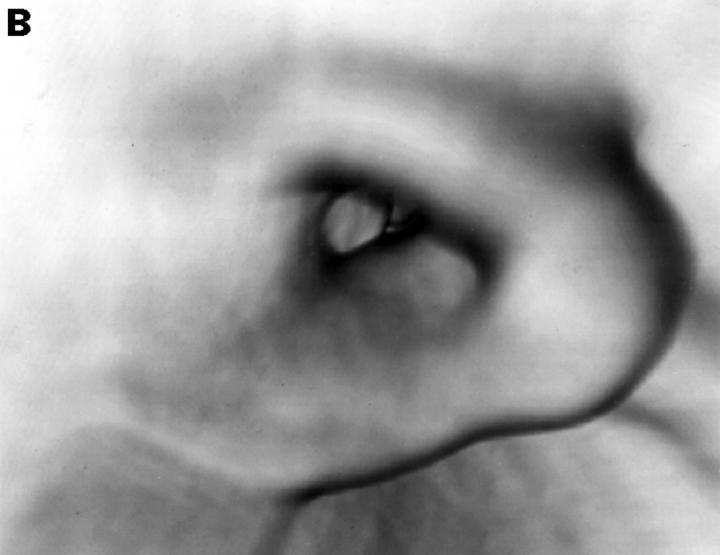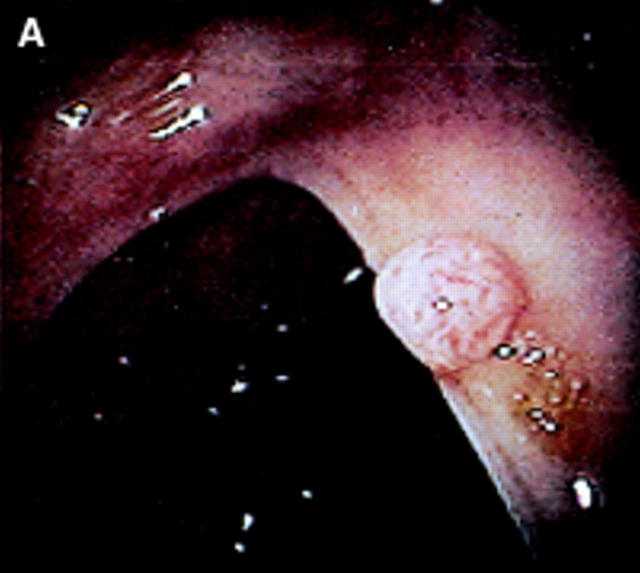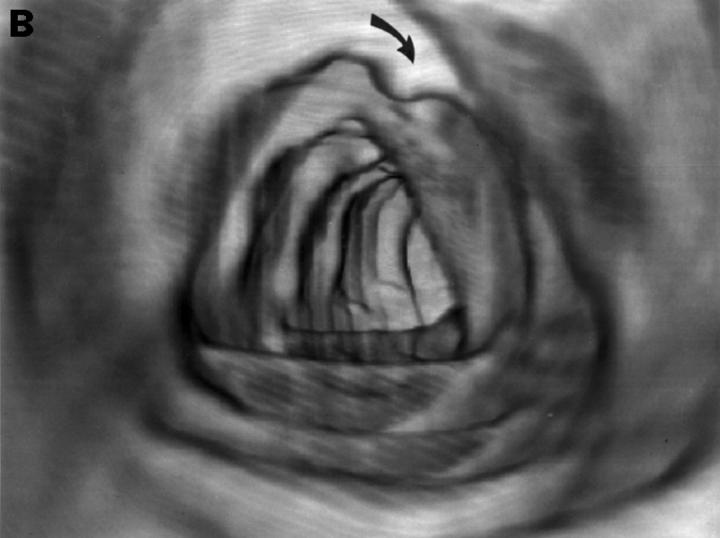Abstract
Background—Virtual colonoscopy is a potentially powerful tool for non-invasive colorectal evaluation. In vitro studies have established its accuracy in simulated polyp detection but little data exist regarding its use in clinical practice. Aims—To evaluate the ability of virtual colonoscopy to detect colorectal cancers and polyps in patients with endoscopically proven colorectal neoplasms and to correlate the findings of virtual colonoscopy with those of conventional colonoscopy, surgery, and histopathology. Patients—Thirty eight patients with endoscopic findings suggestive of colorectal carcinoma. Methods—Virtual colonoscopy was performed using thin section helical computed tomography (CT) of the abdomen and pelvis after rectal insufflation of room air. Commercially available software was used to generate endoscopic "fly through" examinations of the colon from the CT data. Results were correlated with the findings of conventional colonoscopy and with the surgical and histopathological outcome in each case. Results—Thirty eight pathologically proven colorectal cancers and 23 adenomatous polyps were present. On virtual colonoscopy, all cancers and all polyps measuring greater than 6 mm in size were identified; there were two false positive reports of polyps. On conventional colonoscopy, there was one false positive report of a malignant sigmoid stricture; four subcentimetre polyps were overlooked. Virtual colonoscopy enabled visualisation of the entire colon in 35 patients; conventional colonoscopy was incomplete in 14 patients. Virtual colonoscopy correctly localised all 38cancers, compared with 32 using conventional colonoscopy. Conclusion—Virtual colonoscopy is a feasible method for evaluating the colon; it may have role in diagnosis of colorectal cancer and polyps.
Keywords: colonic neoplasms; computed tomography; computer simulation
Full Text
The Full Text of this article is available as a PDF (141.9 KB).
Figure 1 .
Normal colon. Virtual colonoscopy (retrograde view) showing normal haustral folds and lumen perspective.
Figure 2 .
Caecal carcinoma. A 2.5 cm caecal carcinoma is shown on both conventional (A) and virtual colonoscopy (B) (arrow). Note smoothing of tumour surface detail, a consistent finding on virtual colonoscopy images.
Figure 3 .
Splenic flexure carcinoma. An annular constricting splenic flexure carcinoma is shown on conventional (A) and virtual colonoscopy (B). Although the tumour could not be passed endoscopically, at virtual colonoscopy the colon proximal to the tumour was clearly visualised and was normal.
Figure 4 .
Transverse colon polyp. A 4 mm polyp is seen on both conventional (A) and virtual colonoscopy (B) (arrow). The typical triangular configuration of the transverse colon is readily appreciated on both conventional and virtual colonoscopy images.
Selected References
These references are in PubMed. This may not be the complete list of references from this article.
- Ahlquist D. A., Johnson C. D. Screening in cyberspace: the next generation? Gastroenterology. 1997 Jun;112(6):2150–2152. doi: 10.1053/gast.1997.v112.agast972150. [DOI] [PubMed] [Google Scholar]
- Amin Z., Boulos P. B., Lees W. R. Technical report: spiral CT pneumocolon for suspected colonic neoplasms. Clin Radiol. 1996 Jan;51(1):56–61. doi: 10.1016/s0009-9260(96)80221-2. [DOI] [PubMed] [Google Scholar]
- Dachman A. H., Lieberman J., Osnis R. B., Chen S. Y., Hoffmann K. R., Chen C. T., Newmark G. M., McGill J. Small simulated polyps in pig colon: sensitivity of CT virtual colography. Radiology. 1997 May;203(2):427–430. doi: 10.1148/radiology.203.2.9114099. [DOI] [PubMed] [Google Scholar]
- Farley D. R., Bannon M. P., Zietlow S. P., Pemberton J. H., Ilstrup D. M., Larson D. R. Management of colonoscopic perforations. Mayo Clin Proc. 1997 Aug;72(8):729–733. doi: 10.1016/S0025-6196(11)63592-1. [DOI] [PubMed] [Google Scholar]
- Fenlon H. M., Bell T. V., Ahari H. K., Hussain S. Virtual cystoscopy: early clinical experience. Radiology. 1997 Oct;205(1):272–275. doi: 10.1148/radiology.205.1.9314998. [DOI] [PubMed] [Google Scholar]
- Fenlon H. M., Ferrucci J. T. Virtual colonoscopy: what will the issues be? AJR Am J Roentgenol. 1997 Aug;169(2):453–458. doi: 10.2214/ajr.169.2.9242753. [DOI] [PubMed] [Google Scholar]
- Hara A. K., Johnson C. D., Reed J. E., Ahlquist D. A., Nelson H., Ehman R. L., Harmsen W. S. Reducing data size and radiation dose for CT colonography. AJR Am J Roentgenol. 1997 May;168(5):1181–1184. doi: 10.2214/ajr.168.5.9129408. [DOI] [PubMed] [Google Scholar]
- Hara A. K., Johnson C. D., Reed J. E., Ahlquist D. A., Nelson H., Ehman R. L., McCollough C. H., Ilstrup D. M. Detection of colorectal polyps by computed tomographic colography: feasibility of a novel technique. Gastroenterology. 1996 Jan;110(1):284–290. doi: 10.1053/gast.1996.v110.pm8536869. [DOI] [PubMed] [Google Scholar]
- Hara A. K., Johnson C. D., Reed J. E., Ehman R. L., Ilstrup D. M. Colorectal polyp detection with CT colography: two- versus three-dimensional techniques. Work in progress. Radiology. 1996 Jul;200(1):49–54. doi: 10.1148/radiology.200.1.8657944. [DOI] [PubMed] [Google Scholar]
- Johnson P. T., Heath D. G., Bliss D. F., Cabral B., Fishman E. K. Three-dimensional CT: real-time interactive volume rendering. AJR Am J Roentgenol. 1996 Sep;167(3):581–583. doi: 10.2214/ajr.167.3.8751655. [DOI] [PubMed] [Google Scholar]
- Kauczor H. U., Wolcke B., Fischer B., Mildenberger P., Lorenz J., Thelen M. Three-dimensional helical CT of the tracheobronchial tree: evaluation of imaging protocols and assessment of suspected stenoses with bronchoscopic correlation. AJR Am J Roentgenol. 1996 Aug;167(2):419–424. doi: 10.2214/ajr.167.2.8686619. [DOI] [PubMed] [Google Scholar]
- Kay C. L., Evangelou H. A. A review of the technical and clinical aspects of virtual endoscopy. Endoscopy. 1996 Nov;28(9):768–775. doi: 10.1055/s-2007-1005603. [DOI] [PubMed] [Google Scholar]
- Rex D. K., Cutler C. S., Lemmel G. T., Rahmani E. Y., Clark D. W., Helper D. J., Lehman G. A., Mark D. G. Colonoscopic miss rates of adenomas determined by back-to-back colonoscopies. Gastroenterology. 1997 Jan;112(1):24–28. doi: 10.1016/s0016-5085(97)70214-2. [DOI] [PubMed] [Google Scholar]
- Royster A. P., Fenlon H. M., Clarke P. D., Nunes D. P., Ferrucci J. T. CT colonoscopy of colorectal neoplasms: two-dimensional and three-dimensional virtual-reality techniques with colonoscopic correlation. AJR Am J Roentgenol. 1997 Nov;169(5):1237–1242. doi: 10.2214/ajr.169.5.9353434. [DOI] [PubMed] [Google Scholar]
- Rubin G. D., Beaulieu C. F., Argiro V., Ringl H., Norbash A. M., Feller J. F., Dake M. D., Jeffrey R. B., Napel S. Perspective volume rendering of CT and MR images: applications for endoscopic imaging. Radiology. 1996 May;199(2):321–330. doi: 10.1148/radiology.199.2.8668772. [DOI] [PubMed] [Google Scholar]
- Rubin G. D., Napel S., Leung A. N. Volumetric analysis of volumetric data: achieving a paradigm shift. Radiology. 1996 Aug;200(2):312–317. doi: 10.1148/radiology.200.2.8685316. [DOI] [PubMed] [Google Scholar]
- Schoenenberger A. W., Bauerfeind P., Krestin G. P., Debatin J. F. Virtual colonoscopy with magnetic resonance imaging: in vitro evaluation of a new concept. Gastroenterology. 1997 Jun;112(6):1863–1870. doi: 10.1053/gast.1997.v112.pm9178678. [DOI] [PubMed] [Google Scholar]
- Summers R. M. Navigational aids for real-time virtual bronchoscopy. AJR Am J Roentgenol. 1997 May;168(5):1165–1170. doi: 10.2214/ajr.168.5.9129406. [DOI] [PubMed] [Google Scholar]
- Vining D. J. Virtual endoscopy: is it reality? Radiology. 1996 Jul;200(1):30–31. doi: 10.1148/radiology.200.1.8657938. [DOI] [PubMed] [Google Scholar]



